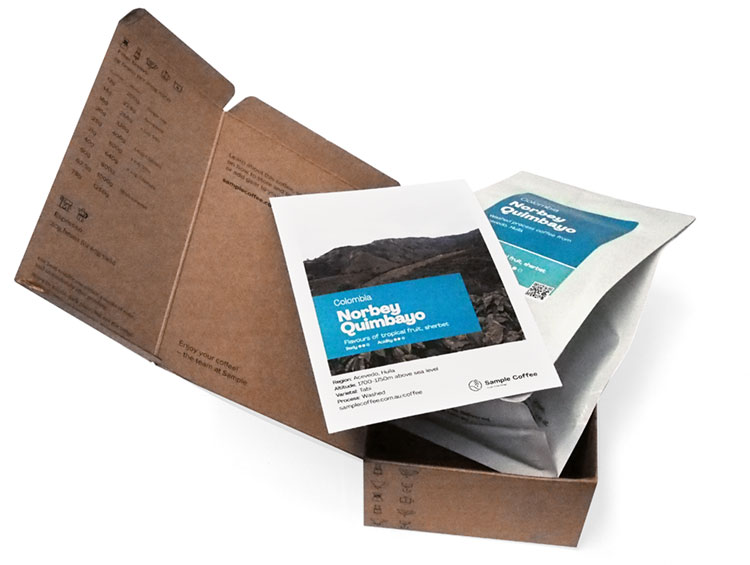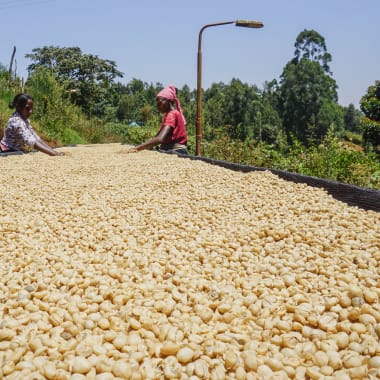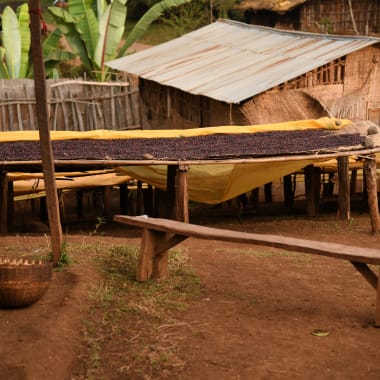-
Producer
-
Jabanto Producers
-
Country
- Ethiopia
-
Region
-
Kochere
-
Altitude
-
2000m above sea level
-
Variety
-
Process
-
Importer
-
Condesa Co.Lab
-
Body
-
Light
-
Acidity
-
Bright
-
Tasting notes
-
Turkish delight, strawberry bubblegum, passionfruit
-
Roast style
Ethiopia
Jabanto Producers
Carbonic MacerationThe Jabanto group tries to produce different coffee types: regional lots, village level lots, single farmer lots, variety lots and processing lots. The collaboration between Bi-Lab (Ethiopia) and Co-Lab (Australia) could help better define coffee sourcing approaches, quality control mechanisms, marketing and promotion opportunities for farmers.
From the same cooperative group as Jabanto Honey and Adebe Cherfo, this coffee has been fermented using a relatively new and young method borrowed from the winemaking industry.
VERY SPECIAL
Jabanto Carbonic Maceration is the first feature of our new Brew Crew VS subscription. We’ve chosen it for its outstanding cupping quality and extremely fruity flavours—a product of its unique fermentation process. But what makes it extra special for us is what it represents: an intersection between ancient and modern.
This particular lot is an Ethiopian heirloom. It’s a classic varietal, grown and harvested in the coffee’s historical birthplace. However, the fermenting method is one of the most contemporary and cutting-edge methods. Old meets new to create a delicate treat that we’re lucky to experience.
LINKS WITH WINE
If you’re into grape juice, you probably have heard of carbonic maceration before. In winemaking, it refers to a fermenting process occurring in an enclosed vessel, where oxygen is limited, carbon dioxide is rich and a percentage of berries are uncrushed. It was first used in a controlled environment as early as the 1930s—surprise— in France.
“Most wine transforms from grape juice into alcohol via a yeast fermentation. Bunches of grapes are picked, destemmed and crushed. The yeast, whether naturally present on the grape skins or added by winemakers, ‘eat’ the natural sugars in the grape juice and converts them into alcohol.” However, “In carbonic maceration, however, the initial fermentation is not caused by yeast, but instead occurs intracellularly, or from the inside out.” (Source: winemag.com)
JUMP INTO THE COFFEE WORLD
There is little information on when and how this technique started to infiltrate the coffee world. However, we know the exact moment it became popular: the 2015 World Barista Championship, won by Saša Šestić with a carbonic maceration process coffee.
Saša developed it in collaboration with Colombian farmer Camilo Merizalde after learning about its use in wine.
This fermentation method is considered still young in the industry and its use is not very much extended. Compared to other processes, such as washed, carbonic maceration could be volatile, hard to replicate and somewhat unpredictable in terms of quality and flavour results. Hence lots like this one of Jabanto are small and represent a tiny percentage of the producer’s output; farmers’ can’t risk all their harvest to a process that is still not yet completely understood and mastered.
THE CARBONIC MACERATION PROCESS
Just as in wine, the process starts by placing whole, uncrushed and ripe berries inside an airtight container. With time, as coffee ferments, the sugars are broken down by bacteria into CO2 and alcohol; the more CO2 is released, the more the pressure inside the vessel builds up.
The resulting environment is an oxygen-poor atmosphere, isolated from external conditions. Each cherry ferments from the outside-in and, theoretically, independently from weather and other conditions linked to the processing station.


“According to Šestić, all the flavours and aromatics produced by carbonic maceration have no way to escape. Instead, they’re absorbed by the coffee parchment, contributing to a ‘stoned fruit’ quality in the cup. During the process, they use low temperatures to avoid alcohol build-up.” (Source: mtpak.coffee)
In the case of Jabanto CM, the cherries ferment in the tank for about 60 hours, and then transferred onto a raised bed, where they sundry for some additional 10-12 days.
BREW, SHARE AND ENJOY
Now you know a bit more about the background it’s time to enjoy this awesome coffee! If you don’t know where to start, you can use Reuben’s brewing recipe shared here on the brewing notes (see below in this page).
You can also try your favourite method and play around with some settings to get the best of it. Don’t forget to tell us how it went, registering your recipe here, via email or on Instagram at @samplecoffee.
We look forward to hearing about your experience with this VS coffee!
FURTHER INFO
- Post-Harvest Coffee Processing: Anaerobic Fermentation and Carbonic Maceration, Royal NY
- EXPERIMENTAL FERMENTATION IN COFFEE PROCESSING, Plot Roasting
Learn everything about this coffee:
Ethical, traceable sourcing
This page has all the sourcing information (variety, process, region, story, importer, and more) that our importers share with us, and give us permission to use.
The transparency helps us talk confidently about the quality and background of our product, and it helps you know exactly what you’re buying.
Learn more:
Coffee page transparency legend
Our coffee philosophy
Our business approach
Fresh harvest coffee
We only source and roast coffee from each country’s latest harvest season (so the green coffee is never older than 1 year from the time of picking, processing and packing). This ensures the sensory qualities are always at their peak and unaffected by excessive ageing.
Roasted for espresso and filter (best enjoyed black)
Roast style: omni. Omni roasts are designed to brew and taste great both as espresso and filter. Our omni single origins generally sit on Agtron values in the ~70-60 value range. So, technically, they are somewhere in the lighter side of the medium spectrum.
Designed for espresso and filter brewing. Best enjoyed black.
Learn more:
Our Loring Kestrel S35 roaster
Our roasting style and approach
Best brewed within days 15-49 post-roast
The ‘fresh is best’ saying doesn’t apply to coffee (contrary to popular belief). Waiting before opening and brewing your bag of whole coffee beans helps develop peak flavour and acidity.
But heads up: if you buy pre-ground coffee, brew it as soon as possible.
Learn more:
Our recommended brewing window
Try our custom brewing recipes
Our recipes and ratios are tailored to our coffee sourcing and roasting styles, bringing the best flavour and feel out of each coffee.
For pour over, immersion, and other filter brewing styles, check our brew guides.
For our espresso single origins, we recommend a coffee:yield ratio of 1:3:
- Dose: 20g ground coffee
- Yield: 60g espresso
- Total brew time: ~24-28 seconds
This is just a starting point! We encourage you to experiment, taste, and adjust to find the recipe that you enjoy the most.
Learn more:
Our espresso brew guide (single origin)
Brewing ratio calculator
Packaging and sustainability
- Bags: ABA-certified home compostable (AS 5810-2010)
- Labels: recyclable
- Valves (only on +250g bags): general waste
- Box and tape (online orders): recyclable
Learn more:
Our packaging
Variety
Ethiopian Heirloom variety
Heirloom (or sometimes Landrace) is an umbrella term that refers to all the coffee varietals endemic to Ethiopia.
The location
Coffee from Ethiopia
Seen as the birthplace of domesticated coffee, there are not many more exciting times at the Sample warehouse as when our fresh Ethiopian lots arrive. Legend says it’s our favourite origin…
Farm processes
Carbonic Maceration (Anaerobic Natural) process
This technique leaves some flesh on the coffee cherry during processing and drying. This results in flavours which may show jammy fruit and a little winey-ness.
2 brew notes from subscribers
Ethiopia Jabanto Producers Carbonic Maceration
John’s V60
Sample Coffee Team
- 30g
- 500ml
- 4m 20s
Ethiopia Jabanto Producers Carbonic Maceration
Reuben’s V60
Sample Coffee Team
- 30g
- 500ml
- 3m 40s

Subscribe to a world of coffee
Discover a new single origin coffee from Sample every 1-5 weeks with no delivery fees.
No up-front purchase, and you can pause, cancel, or change plans at any time.
Available to order online this week:

Ethiopia Bekele Gemeda
Flavours of mandarin, white peach, mango
Body Acidity
Washed Ethiopian Heirloom
November 2024 harvest
Roasted omni for filter and espresso
Ethiopia Bekele Gemeda online
Ethiopia Girma Sintayehu Honey
Flavours of apricot, mango, coconut, pineapple
Body Acidity
Honey 75227, Wolisho
February 2025 harvest
Roasted omni for filter and espresso
Ethiopia Girma Sintayehu Honey online
Kenya Karindundu Aa
Flavours of orange marmalade, grapefruit, Yunnan red tea
Body Acidity
Washed Batian, SL28, SL34, Ruiru 11
Roasted omni for filter and espresso
Kenya Karindundu Aa online
Colombia Carlos Imbachi Pink Bourbon
Flavours of pear, jasmine, sugarcane
Body Acidity
Washed Pink Bourbon
February 2025 harvest
Roasted omni for filter and espresso
Colombia Carlos Imbachi Pink Bourbon online